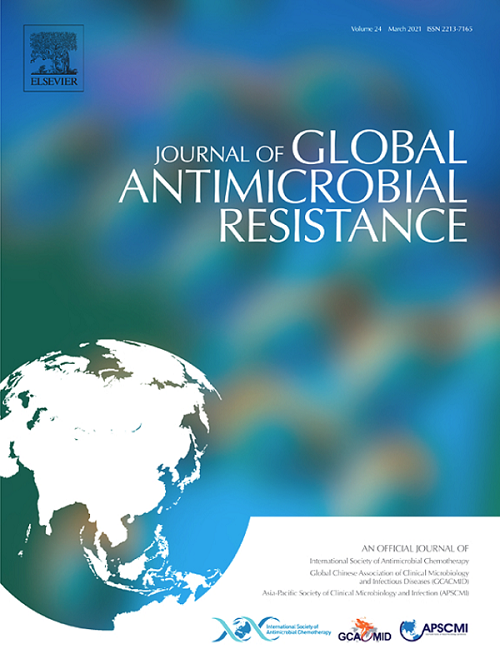Low GAS carriage in school-aged children in western China during the national atypical scarlet fever resurgence: Insights from two cross-sectional studies
IF 3.7
3区 医学
Q2 INFECTIOUS DISEASES
引用次数: 0
Abstract
Introduction
This study examined group A streptococcus(GAS) carriage, emm types, and antibiotic susceptibility in children (6–13 years) in Aral, China, during the post-COVID-19 scarlet fever resurgence, providing regional insights.
Methods
The prevalence of GAS carriage was assessed in 1,835 children aged 6–13 years across two surveys at an Aral school in China during the post-COVID-19 resurgence of scarlet fever. GAS isolates were analyzed for emm types, M1UK lineage, and antimicrobial susceptibility using culture, PCR, sequencing, and automated methods.
Results
The first survey (885 children) showed a 1.9% isolation rate, highest in 9-year-olds (4.8%) and slightly higher in boys (2.3% vs. 1.5%, P > 0.05). The second survey (950 children) reported a 3.1% rate, peaking at 10 years (6.7%) and also higher in boys (3.5% vs. 2.6%, P > 0.05). Colonization rates were similar overall (P > 0.05), but increased significantly in children aged ≥10 years (1.1% to 3.3%, P = 0.038). No children tested positive for GAS in both sampling rounds, which meant that the two surveys identified distinct host populations colonized by the bacteria. Emm12 prevalence decreased from 76.5% to 55.2% (P > 0.05), while emm1 increased from 11.8% to 31.0% (P > 0.05), with no M1UK lineage detected. All isolates were sensitive to penicillin, linezolid, vancomycin, and levofloxacin. Among 33 co-resistant isolates, emm12 accounted for 84.8% and emm1 for 15.2%.
Conclusion
Despite low GAS carriage rates, variations in age distribution and emm types suggest increased bacterial activity, warranting ongoing monitoring for GAS-related diseases.
中国西部学龄儿童在全国非典型猩红热卷土重来期间的低气体运输:来自两项横断面研究的见解。
本研究调查了中国咸海地区6-13岁儿童(6-13岁)在2019冠状病毒病后猩红热卷土重来期间的A组链球菌(GAS)携带、emm类型和抗生素敏感性,提供了区域见解。方法:在2019冠状病毒病后猩红热卷土重来期间,在中国咸海地区一所学校进行两次调查,评估1835名6-13岁儿童携带GAS的流行情况。使用培养、PCR、测序和自动化方法分析GAS分离株的emm类型、M1UK谱系和抗菌敏感性。结果:第一次调查(885例)患儿的隔离率为1.9%,其中9岁患儿隔离率最高(4.8%),男童隔离率略高(2.3% vs. 1.5%, P < 0.05)。第二次调查(950名儿童)报告了3.1%的比例,10岁时达到峰值(6.7%),男孩的比例也更高(3.5% vs. 2.6%, P < 0.05)。总体上菌落率相似(P < 0.05),但≥10岁儿童的菌落率显著增加(1.1% ~ 3.3%,P = 0.038)。在两次抽样中,没有儿童的气体检测呈阳性,这意味着两次调查确定了由细菌定植的不同宿主种群。Emm12患病率从76.5%下降到55.2% (P > 0.05),而emm1患病率从11.8%上升到31.0% (P > 0.05),未检测到M1UK谱系。所有分离株均对青霉素、利奈唑胺、万古霉素和左氧氟沙星敏感。33株共耐药菌株中,emm12占84.8%,emm1占15.2%。结论:尽管GAS携带率低,但年龄分布和emm类型的变化表明细菌活性增加,需要对GAS相关疾病进行持续监测。
本文章由计算机程序翻译,如有差异,请以英文原文为准。
求助全文
约1分钟内获得全文
求助全文
来源期刊

Journal of global antimicrobial resistance
INFECTIOUS DISEASES-PHARMACOLOGY & PHARMACY
CiteScore
8.70
自引率
2.20%
发文量
285
审稿时长
34 weeks
期刊介绍:
The Journal of Global Antimicrobial Resistance (JGAR) is a quarterly online journal run by an international Editorial Board that focuses on the global spread of antibiotic-resistant microbes.
JGAR is a dedicated journal for all professionals working in research, health care, the environment and animal infection control, aiming to track the resistance threat worldwide and provides a single voice devoted to antimicrobial resistance (AMR).
Featuring peer-reviewed and up to date research articles, reviews, short notes and hot topics JGAR covers the key topics related to antibacterial, antiviral, antifungal and antiparasitic resistance.
 求助内容:
求助内容: 应助结果提醒方式:
应助结果提醒方式:


